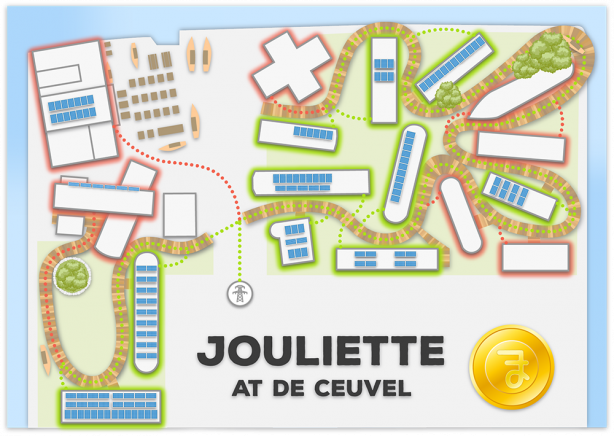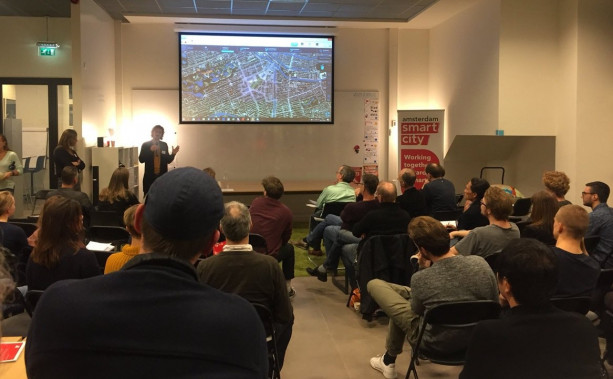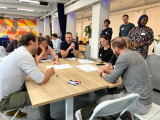Can you power a concert with car batteries? And how does blockchain technology enable energy sharing amongst neighbours? On the 30th of November, the last Smart City, Smart Data session took place at the DataLab Amsterdam. This time we focused on the potential of Smart Energy grids, storage and the role of data in this. Read the full review here.
Tom van Arman moderated the session last Thursday. He is the founder of Tapp, an app development company, and knows all about exchanging energy profession, as well as from experience with the battery he has in his own home. As an introduction, the Smart City, Smart Data session first shed a light on what DataLab and Amsterdam Smart City are doing for the city of Amsterdam.
Green IT
As this event was held during the GreenIT week, Julie Chenadec spoke about the potential of Amsterdam to increase efficiency in its current tech infrastructure. GreenIT Amsterdam elaborated on their search for a sustainable datacentre; finding the ideal spot where heat produced by these centres can be transferred to houses connected to the public heat grid. “Through the Energy Atlas visualisation, untapped energy transfer opportunities are discovered”.
Amsterdam Innovation Arena
Henk van Raan represented the Amsterdam ArenA, partner of Amsterdam Smart City. The Amsterdam ArenA always wants to innovate, and since a couple of years they focus mainly on three themes: fan experience, mobility and energy, Henk said.
Focusing on the Energy topic, Henk explained that the Amsterdam ArenA plans to build a big battery that can supply power for the ArenA and neighbouring venues during events. This way, the energy taken from the grid will be reduced. The batteries will be charged throughout the week by solar panels and small wind mills on the roof. These batteries can increase the reliability of power and “shave” the peaks during times of high energy consumption, meaning that less power has to be drawn directly from the grid. The surrounding neighbourhood is involved in the development of the area, and can share the energy amongst each other. But there’s more to this Smart Grid.

Energy, Mobility and Customer Experience all come together with the idea of Vehicle 2 Grid in the Amsterdam ArenA. The idea is simple: people drive their electric vehicle to the ArenA, discharge their car batteries (only a small amount) in exchange for free parking (or another form of compensation) and drive off after the event knowing they have provided the energy to e.g. power the microphone during a U2 concert, or the stadium lights during an Ajax match. This creates a unique fan experience as all the visitors together make the event possible using their own assets.
Alliander DGO
Jeroen Wijnen and Joanne de Vink represented Alliander DGO (Sustainable Area Development). They have been working on a project called HEAT. HEAT gives local stakeholders the opportunity to co-design and develop an open heat grid. Therefore it uses 3D modelling and gamification to make the often complex decision processes go smoother. In essence, HEAT combines different open data sets and uses financial and technical models to calculate how different decisions affect stakeholders in real-time, providing an immediate and clear understanding of collective goals and interests, funding, and the sustainability of the design. Curious to know more? Checktheir website here.
Spectral
Our last presenter from Spectral informed us on the application of blockchain to smart energy. Several examples of Spectral’s smart energy implementations were provided including Blijburg, a beach café-restaurant that now uses Spectral’s systems to optimize their energy efficiency and maximise savings through a custom-built battery with energy management system and advanced VRV heat exchange system, and Schoonship, an upcoming sustainable, floating neighbourhood in Buiksloterham where Spectral are responsible for smart-grid infrastructure, energy storage, and renewable energy systems. Spectral also presented the Jouliette: the blockchain-based energy token that allows for peer-to-peer energy trading. The first implementation of the Jouliette is at the Ceuvel, where it is used to exchange renewable energy between neighbours using blockchain as a distributed ledger for the microgrid. There are plans to expand the Jouliette into other intra-community services (such as car-sharing and biological waste management) and beyond the Ceuvel and into further implementations at locations across Amsterdam Noord. Check out more of Spectral’s projects on their webpage.

Do you want to be part of this movement or have inspiring ideas for a better future join the community on www.amsterdamsmartcity.com
As this was our last DataLab session this year, we want to thank all speakers, co-organizers and attendees of these sessions and hope to be inspiring you next year with similar events! Also, a big shout out to DataLab for having us! Keep an eye out on our events page, we hope to see you soon.
Wishing you well,
The Amsterdam Smart City Team







@noudverhave We saw you added your project to the site here, great! And thank you for this compliment. We hope to see you at our future events too!
Great ideas on this Smart Data session!!
Do you know KAREL (KAR voor Elektriciteit op Locatie) or CAREL in English (CAR for Electricity on Location). KAREL provides (sunpowered) green energy for (cultural) events on location, for example a concert, a theatre play, a festival and more. Do you want to know more? See https://www.facebook.com/KARvoorELEKTRICITEITopLOCATIE/
KAREL is an initiative of Moving Arts Project.
We hope to join next year in one of the Smart Data sessions.